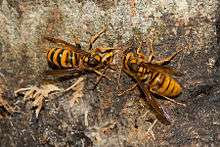Vespa simillima
| Vespa simillima | |
|---|---|
.jpg) | |
| Vespa s. simillima | |
 | |
| V. s. xanthoptera | |
| Scientific classification | |
| Kingdom: | Animalia |
| Phylum: | Euarthropoda |
| Class: | Insecta |
| Order: | Hymenoptera |
| Family: | Vespidae |
| Genus: | Vespa |
| Species: | V. simillima |
| Binomial name | |
| Vespa simillima Smith, 1868 | |
| Subspecies | |
| |
| Synonyms | |
| |
Vespa simillima, including the subspecies known as the Japanese hornet or Japanese yellow hornet (Vespa simillima xanthoptera) (キイロスズメバチ), is a common hornet species in the Eastern Hemisphere. V. s. simillima (Japanese:ケブカスズメバチ, Korean: 털보말벌, "Hairy Wasp") is darker and hairier than V. s. xanthoptera. V. s. simillima lives in Hokkaido, the Korean Peninsula, Eastern Siberia and China. It should not be confused with the Asian giant hornet (Vespa mandarinia), whose subspecies V. m. japonica is sometimes referred to as the Japanese giant hornet. In Japan, V. s. xanthoptera is more common than V. s. simillima. In Korea, V. s. xanthoptera only lives in Jejudo.
Biology
Due to the great scale of the swarm and aggressiveness of the yellow hornet, predation against yellow hornets is rare. However, along with other insects in Japan and Korea, they are prey to the Asian giant hornet, and nests have been known to be deserted after giant hornet attacks, even though they attack in groups of only 10 to 30.
Nests of the yellow hornet are sometimes attacked by the parasitic species Vespa dybowskii. In the early stage of nesting, the queen of Vespa dybowskii attacks the queens of other hornets, including the yellow hornet and European hornet. If the assault succeeds, it will usurp the nest to produce its own offspring, assisted by the workers of the former owner.
The yellow hornet has the largest swarms of all of the hornet species, containing one to two thousand workers. Although the yellow hornet is much smaller than the Japanese giant hornet, it can be more dangerous to humans because they will attack people in greater numbers.